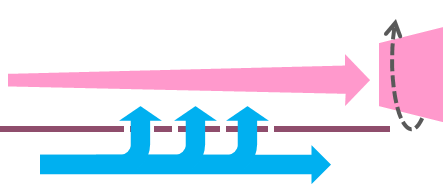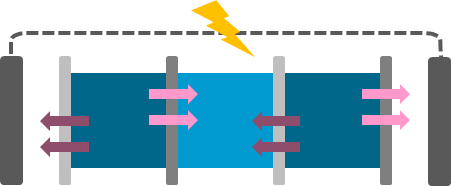In this series on capturing energy from the ocean we’ve recently discussed wave power, tidal power and OTEC. There is, however, another lesser known (and slightly less developed) way of capturing energy from the ocean. This is salinity gradient power (or osmotic power or blue energy), which, as the name suggests, utilises the saltiness of the ocean to generate electricity. These systems make use of the salt content difference between seawater (or other types of salt-containing water) and fresh water (such as is found in rivers and estuaries).
How does it do that? There are currently two predominant techniques used to generate electricity, which we discuss below.
Pressure-retarded osmosis (PRO)
PRO, which is used by companies like SaltPower, is predominantly based on osmosis, which is the movement of a solvent (i.e. something that can dissolve other substances) through a semi-permeable membrane from a less concentrated solution to a more concentrated one.
In the case of the PRO process, the solvent is water. To generate electricity from osmosis, a water permeable membrane (i.e. a membrane that allows the passage of water but not salt) is positioned between a stream of fresh water and a stream of seawater. As the stream of seawater has a much higher salt content (so is more concentrated), the fresh water flows into the seawater stream through the membrane via osmosis.
The influx of freshwater into the seawater stream increases the pressure in that stream which drives a turbine to generate electricity.

Reversed electrodialysis (RED)
Like PRO, RED uses membranes positioned between streams of seawater and fresh water to produce electricity. In this case, however, it is ions (charged atoms) travelling across the membranes rather than water. Ions are present in the seawater due to its salt content.
A RED system (such as that being developed by Sweetch Energy) includes a row of adjacent streams separated by membranes. The streams alternate between seawater and freshwater. The membranes alternate between “cation” (positively charged ion) and “anion” (negatively charged ion) exchange membranes. Each cation exchange membrane allows the passage of cations only, and each anion membrane allows the passage of anions only.
Like in the PRO system, there is movement across the membranes, but in this case because it is movement of ions, the movement is in the direction from the seawater to the freshwater. Each seawater channel is bounded on opposite sides by a cation exchange membrane and an anion exchange membrane. This means that the positively charged ions and negatively charged ions in the seawater, driven by the salinity difference, move in opposite directions. Electrodes are placed at opposite ends of the stack to convert the movement of ions into an electrical current.

What are the issues?
Salinity gradient power is still at a developmental stage, largely (as is often the case) because these processes are expensive. As it stands, the cost of producing electricity from these processes is far greater than, for example, wind energy.
Both the PRO and RED processes rely on membranes to generate electricity and the types of membranes required for these processes can be costly. The membranes and other components, for example, suffer from biofouling. Then there are also costs associated with maintaining and operating the various components of the system – for example, in both cases the seawater and freshwater must be pumped, which requires electricity.
Cost is not the only issue, though. There are also environmental concerns. The output of each of these processes is brackish water (slightly salty water). The release of this water (especially in large quantities) back into the natural environment could change the water quality of that environment, impacting the local ecosystem. Likewise, water intakes and discharge points present a risk to organisms in the respective waterway.
What is being done to solve the cost issues?
Given the membranes make up an estimated 50-80% of total capital costs, developing cheaper, more efficient membranes will go a long way to making salinity gradient power generation commercially viable. Fortunately, there are researchers working on this exact problem. Institute of Frontier Material researchers, for example, are working on 2D nanomaterial materials that can be used in membranes, and which they say boost energy generation.
Another way to make these systems produce more energy for the same cost is to use water with a higher salt content – at least in the PRO process, the higher the gradient the larger the “osmotic pressure” which drives water from the fresh water stream to the salt water stream. One option is to simply find a saltier body of water – in fact, the idea for the PRO process (by Sidney Loeb) is said to have been inspired by the massive salinity difference at the mouth of the River Jordan, which flows into the Dead Sea, one of the world’s saltiest bodies of water. Another option is to use other sources of water, such as the brine that is output from desalination or geothermal plants.
What’s next?
Like many of the ocean energy capturing techniques we’ve discussed, salinity gradient power has huge theoretical potential – it’s estimated that it could meet 80% of the world’s energy demands. Salinity gradient power is a long, long way off that potential – it still, of course, needs to hit that first step of finding a solution that is commercially viable. Nevertheless, with continuing research into membranes based on nanotechnology and the identification of niche applications with highly saline brine, it seems likely that such a commercial solution is not too far off.
To learn more about marine and ocean engineering or talk to one of our specialists, visit our Spotlight Page.
Ben is a Partner and Patent Attorney at Mewburn Ellis. Ben is experienced in patent drafting, prosecution and Freedom to Operate within the mechanical engineering, medical device and consumer products sectors. He also deals with filing and infringement issues relating to registered and unregistered designs.
Email: ben.boyd@mewburn.com
/BEN%20BOYD-author.png?width=100&height=100&name=BEN%20BOYD-author.png)

-1.png)